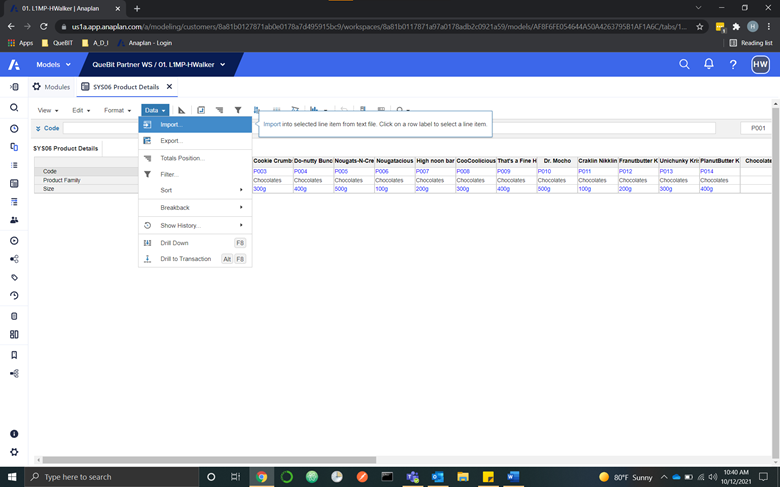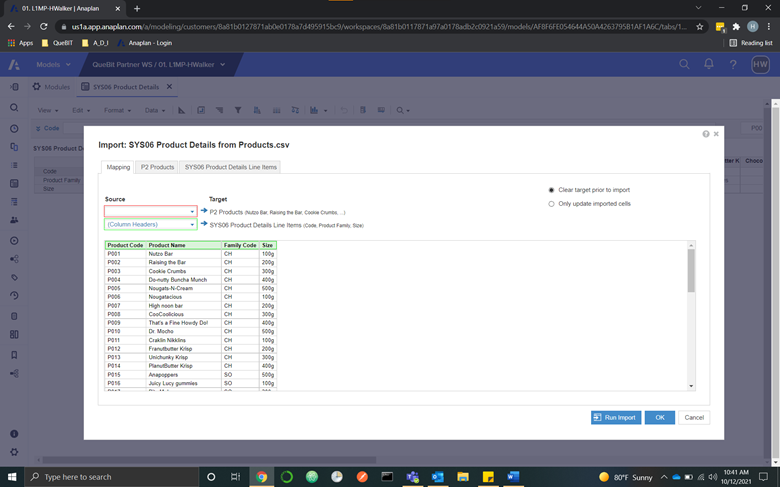Anaplan offers various ways of integrating data into the platform. The decision of how to import and export data is dependent on the context surrounding the use case. Who is going to own the data integration process moving forward? What technical know-how do they currently possess? What does your data architecture consist of? Or to be more granular, will the source data need to be transformed prior to import, what kinds of ETL tools are in use, what is the volume of the data sources, and are they consisting of on-premises, software as a service (SaaS), or both? How much automation will be necessary to perform the integration? The choice of integration should be made according to these complexities, and the skill set inherent to the user base. If you or your business are looking to streamline the process of importing and exporting data with Anaplan but aren’t sure which of the many data integration options are right for you: read on!
Manual Import/Export
From the most basic level, Anaplan allows users to import data into a list or module through the Anaplan user interface (UI). This is done simply through the import drop down, where a user would map fields according to the desired outcome. The data may be sourced from either a flat file (.csv, .txt), or another module.
Import into module using the Anaplan UI:

Perform mapping using the Anaplan UI:

Outside of manual import through the UI, Anaplan offers tools such as Anaplan Connect, Anaplan HyperConnect, CloudWorks, Anaplan ETL connectors, including MuleSoft, SnapLogic, and Boomi, the REST API, and connectors for systems and software such as Tableau, DocuSign, and OneCloud.
Anaplan Connect
Anaplan Connect is a self-contained command line client. This tool would be installed on a customer system and would run on any platform possessing either a Java 8 or 11 runtime environment. This service enables data actions including import, export, delete, process, or upload. The data may be sourced from flat files or relational databases. Anaplan Connect enacts the transfer of data through a Windows Batch file or Unix shell script. These scripts may be run per a scheduling software to automate the process.
Using Anaplan Connect to perform integration is a more technically demanding option than most others. While it allows for flexibility and customization in automation and data actions, it requires someone with a working knowledge of Batch and or Shell scripting to make updates. Anaplan provides extensive documentation and some training in terms of getting started with Anaplan Connect.
CloudWorks
CloudWorks is another Anaplan native tool. It is geared toward Amazon Web Services (AWS), Microsoft Azure, and recently, Google BigQuery. Data is directly and seamlessly integrated with these cloud systems. The idea is to allow organizations to entirely skip third party integration tools or on-premises architecture. CloudWorks can be managed with preexisting connectors or RESTful APIs and allows for efficiency through scheduling and automation.
CloudWorks has a low technical barrier to entry. Two-way integration is possible, both pushing and pulling data to and from AWS and other systems. CloudWorks speeds up model-to-model imports and exports in Anaplan due to its native status and is beneficial to both forecasting and planning models.
CloudWorks users must be assigned the Integration Admin role by someone with the Tenant Admin role. The admin would need read or write access to models and workspaces associated with integrations. Furthermore, one would need read for import and write for export permissions related to files in your AWS S3 bucket. There is a CloudWorks API made for creating your own integrations. You can have up to 100 integrations or processes per Tenant, with unlimited import and export actions. Individual files may be up to 1GB, and you can access up to 5,000 workspaces in one Tenant.
REST API
Through the public REST API, one can perform data actions with the Anaplan built bulk APIs, and view and update metadata with the transactional APIs. A user would need all necessary authentication information depending on the API in use and created source data. This, like Anaplan Connect, allows for a great amount of customization, and comes at no extra cost in terms of service fees. However, it is more technically demanding than GUI based options like MuleSoft, Informatica, and others. The time investment and overall cost of ownership has the potential to increase past that of the third-party integration tools given the need to build and maintain it yourself.
Anaplan HyperConnect
Anaplan HyperConnect is powered by Informatica Cloud. This tool allows users an Informatica Cloud license so long as Anaplan is the data source or target. If a company or organization already has an Informatica Cloud license, they will not have to purchase HyperConnect. HyperConnect acts as an ETL tool for both on-premises and cloud applications for Anaplan. Your Informatica Cloud license will provide access to many new connectors. These connectors consist of a large collection of SaaS and on-premises database (DB) and enterprise resource planning (ERP) connectors. Furthermore, there is support for batch-oriented integration, native scheduling, and billing and support provided by Anaplan.
HyperConnect integrates Anaplan with SaaS platforms, like Salesforce and Workday. Informatica Cloud possesses a drag-and-drop functionality, and the ability to perform data transformation as part of the loading process. While HyperConnect and Informatica Cloud together possess wide capabilities and demand less technical ability, they lack the customization options inherent to Anaplan Connect. Informatica Cloud also comes at a steep price, while Anaplan Connect is free to use with the API, given access to an Anaplan Workspace and Model.
MuleSoft, SnapLogic, Dell Boomi, and OneCloud
Anaplan provides connectors to multiple third-party platforms that may be used as integration options. Each of these four services, MuleSoft, SnapLogic, Dell Boomi, and OneCloud are paid options, and may be a good choice for you if your organization currently possesses a license. These platforms function as ETL and enterprise service bus (ESB) tools.
The Anaplan MuleSoft Connector enables users access to Anaplan through the MuleSoft Anypoint Platform. This connector will allow for authentication with CA Certificates, the execution of data actions such as import, export, delete, and Anaplan Process actions, and the scheduling of data transformations. This system supports connection to a database, flat files, on-premises architecture, and many SaaS applications, such as Salesforce.
The Anaplan SnapLogic connector, known as the ‘Anaplan Snap Pack,’ enacts data transfers through the SnapLogic Designer, a browser-based GUI. SnapLogic presents the capability of connecting to anything (apps, data, APIs), anytime (batch, streaming, real-time), anywhere (on-premises, cloud). SnapLogic, with Anaplan, looks to integrate rapidly with enterprise systems with no code. Users can transfer data between models in Anaplan, and from services like SAP, Workday, and Salesforce. For basic use cases SnapLogic is easy for a non-tech-savvy person to utilize. For more complex business problems and integration instances, SnapLogic may require the use of some scripting.
The Anaplan Dell Boomi connector is developed and maintained by Dell. The Dell Boomi AtomSphere Platform provides a GUI where Boomi process developers can design integration processes with other applications including, Salesforce, SAP, and Workday. Through this you can create Boomi processes that import or export to and from Anaplan lists, modules, and users. Outside of SaaS platforms, Boomi can integrate with databases and flat files. Data transformations may also be scheduled within the platform. This option would also require a local Dell Boomi Atom or Atom Cloud.
OneCloud, the OneCloud Integration Studio, and the Anaplan OneCloud connecter, similarly to some of the other mentioned integration options, provide integration with many enterprise applications such as, Oracle Essbase, Oracle Financials Cloud, SAP, Snowflake, and Google BigQuery. OneCloud enables a drag-and-drop GUI and a no code environment.
Power BI, Tableau, and DocuSign
Anaplan also enables access to what is framed as ‘purpose-built integrations.’ These include reporting tools such as, Tableau and Power BI, and DocuSign, a service which allows electronic document signing. If your organization is already using any of these services, installing their respective connectors would be a good choice to make. However, these do not function as fully operational ETL tool.
Export actions from Anaplan can move straight into Power BI, where Anaplan models may be displayed and refreshed according to a set schedule. The Anaplan Tableau connector allows the same, and is a one-way integration, from Anaplan into Tableau. Both tools would allow for reporting to be performed in the respective platform. Both platforms would require a license to use the service.
The Anaplan DocuSign connector, for professional or enterprise customers, and DocuSign pro level accounts, enables the population of DocuSign documents with Anaplan data. These documents can then be sent and tracked, with real-time updates.
Anaplan Tab in Salesforce.com
Salseforce.com administrators can enable an Anaplan tab directly within Salesforce. Then, through VisualForce Page access, Anaplan data may be displayed. This does not act as an integration option but does allow visualization of the data. Native integration between Salesforce and Anaplan is no longer supported, Anaplan recommends the HyperConnect tool instead.
Conclusion
Ultimately the choice of integration option will come down to the questions provided at the beginning of the article. You can separate these options into various categories, some provide a GUI, while others require some amount of programming know-how. Some come at a steep cost, and others come at no-extra cost due to their native to Anaplan nature.
There are numerous documented use cases for each platform. When researching these instances of application, what do you qualify as success, and how scalable, given your potentially unique situation, is a given platform? Many of these solutions operate directly with commonly used iPaas tools and SaaS such as Salesforce and Workday. Due to this, in many cases, these GUI based platforms may be an obvious starting point. A final question to consider is, at what scale will Anaplan exist within your technology stack? The prevalence of Anaplan usage in each organization could dictate integration solution choice.